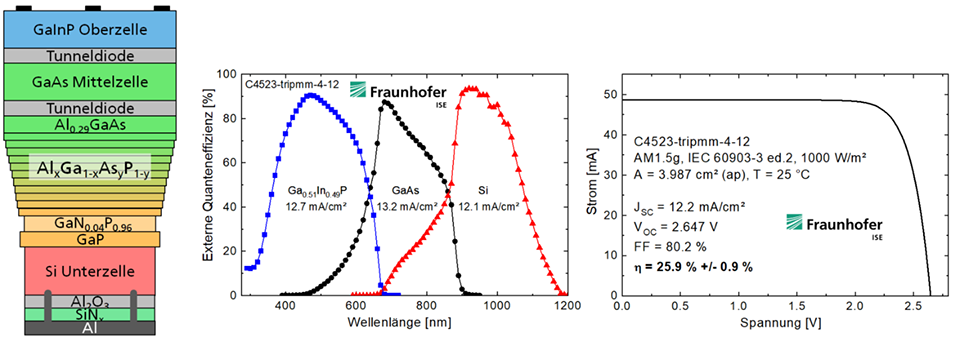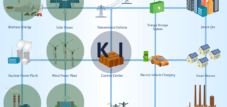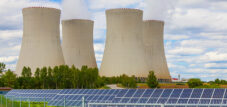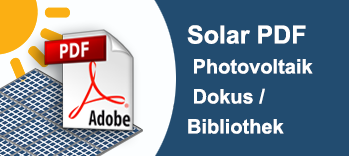New solar cell record – New solar cell record
Language selection 📢
Published on: August 10, 2020 / update from: August 17, 2020 - Author: Konrad Wolfenstein
Switch to english version
Higher efficiencies in tandem – new solar cell record
Photovoltaic research is working hard to further increase the efficiency of solar cells. Increasingly, the focus is on tandem photovoltaics, in which powerful solar cell materials are brought together in different combinations in order to use the solar spectrum even more efficiently when converting light into electrical energy. Fraunhofer ISE has now recorded a new record of 25.9 percent efficiency for a III-V/Si tandem solar cell grown directly on silicon. This was manufactured for the first time on a cost-effective silicon substrate - an important milestone on the way to economical solutions for tandem photovoltaics.
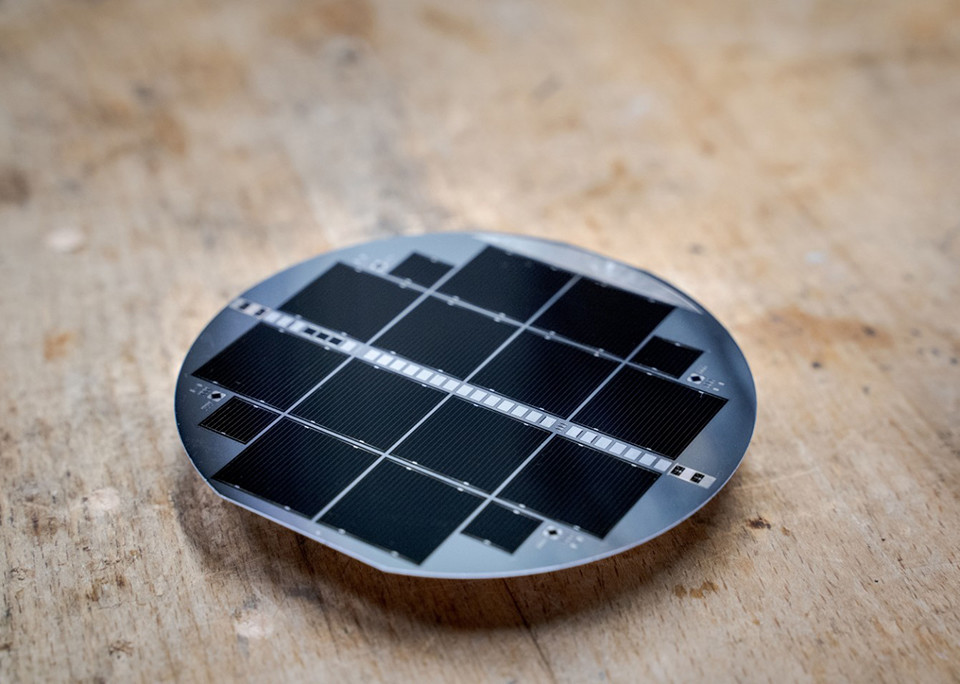
Several III-V tandem solar cells on a silicon substrate with a diameter of 10 cm - © Fraunhofer ISE - Photo: Markus Feifel
The Fraunhofer Institute for Solar Energy Systems ISE has been working for many years on multiple solar cells, in which two or three sub-cells are arranged one on top of the other to convert different wavelengths of sunlight into electricity. Silicon is suitable as an absorber for the infrared part of the spectrum and layers of III-V semiconductors a few micrometers thick are applied on top of it. These are materials from groups III and V of the periodic table, which convert ultraviolet, visible and near-infrared light more efficiently into electricity walk. Pure III-V semiconductor solar cells are already used in space and in concentrator photovoltaics. Through more cost-effective processes in conjunction with silicon as the lowest sub-cell, tandem technology should also be made accessible to broad photovoltaics in the future. However, there is still a long way to go until then.
25.9 percent for III-V/Si tandem solar cells grown directly on silicon
There are different approaches to create combinations of III-V and silicon solar cells. Since 2019, Fraunhofer ISE has held the world record value of 34.1 percent efficiency (now 34.5 percent) for a tandem solar cell in which the III-V semiconductor layers are transferred from a gallium arsenide substrate to silicon, with the layers passing through a so-called wafer -Bond are connected. This technology is efficient but expensive. Fraunhofer ISE has therefore been working for many years on more direct manufacturing processes in which the III-V layers are deposited or epitaxialized onto a silicon solar cell. It is crucial to maintain high crystal quality in all layers – a major challenge. A new world record efficiency of 25.9 percent has now been achieved for such a III-V/Si tandem solar cell grown directly on silicon. Fraunhofer ISE scientist Markus Feifel was recently able to present his success at the 47th IEEE Photovoltaic Specialists Conference, which like many conferences is currently taking place online, and was honored with the Student Award in the Hybrid Tandem Solar Cells category. “The complex internal structure of the cell is not visible from the outside because all the absorbers are connected to each other and electrically connected by additional crystal layers,” explains the young solar cell researcher, who has increased the result of his work from 24.3 to 25.9 in less than a year percent could improve. “This success was achieved by replacing a single thin layer within the multiple cell,” he explains further. "A careful analysis of our cells revealed that this layer created a barrier to electrical conduction."
The Fraunhofer researchers have been developing the technology in small steps since 2007 together with the TU Ilmenau, Philipps Univ. Marburg and the company Aixtron, special epitaxy systems were set up and every single layer of the structure was examined. These developments were funded by the Federal Research Ministry BMBF as part of the “III-V-Si” and “MehrSi” projects. A special highlight of the new tandem solar cell is that the III-V layers were not grown on a chemical-mechanically polished substrate, as was previously the case, but on a silicon wafer, which after sawing the crystal in a simple process using only inexpensive grinding - and etching processes were treated. As part of the European “SiTaSol” project, the Danish company Topsil developed these silicon wafers, thereby taking an important step towards economical production of the new multiple-junction solar cells. In the future, the aim will be to increase efficiency even further and to deposition the layers even faster, with higher throughput and therefore more cost-effectively, with the aim of tandem photovoltaics making an important contribution to the photovoltaics necessary for the energy transition -can achieve expansion.
Key technology for the energy transition
Electricity from solar cells is now the cheapest form of energy generation in many parts of the world. “European photovoltaic research has numerous concepts in progress to further develop the efficiency of this key technology for the energy transition,” says Prof. Dr. Stefan Glunz, Head of Photovoltaics – Research. »We are not only working on making the production of silicon solar cells even more sustainable and cost-effective, but at the same time we are exploring new ways to use the proven silicon in conjunction with other semiconductor materials to achieve even higher efficiencies. We can achieve this with tandem photovoltaics.« Tandem photovoltaics not only opens the way to the future of electricity generation, these solar cells - due to their higher voltage - are also ideal for electrolysis, the direct decomposition of water into hydrogen and oxygen . This technology therefore also contributes to the production of hydrogen as an energy storage device and an important building block for the energy transition.
Layer structure of the III-V/Si multiple solar cell, quantum efficiency and IV characteristics under AM 1.5g spectral conditions
Higher efficiencies in tandem – new solar cell record
Photovoltaics research is working hard to continually increase the efficiency of solar cells. Increasingly, the focus is on tandem photovoltaics, in which high-performance solar cell materials are brought together in various combinations in order to use the solar spectrum even more efficiently in converting light into electrical energy. Fraunhofer ISE is now reporting a new record efficiency of 25.9 percent for a III-V/Si tandem solar cell grown directly on silicon. For the first time, this was produced on a low-cost silicon substrate – an important milestone on the way to economical solutions for tandem photovoltaics.

Several III-V tandem solar cells on a silicon substrate with 10 cm diameter – © Fraunhofer ISE – Photo: Markus Feifel
The Fraunhofer Institute for Solar Energy Systems ISE has been working for many years on multi-junction solar cells in which two or three partial cells are arranged one above the other to convert different wavelengths of sunlight into electricity. Silicon is suitable as an absorber for the infrared part of the spectrum, and layers of III-V semiconductors, materials from groups III and V of the periodic table, which convert the ultraviolet, visible and near-infrared light more efficiently into electricity deposited on top of it. Pure III-V semiconductor solar cells are already used in space and in concentrator photovoltaics. Through more cost-effective processes in combination with silicon as the lowest sub-cell, the tandem technology is to be made accessible for broad-based photovoltaics in the future. However, there is still a long way to go until then.
25.9 percent for III-V/Si tandem solar cells grown directly on silicon
There Are Different Approaches to Produce Combinations of III-V and Silicon Solar Cells. For Example, Since 2019, Fraunhofer Ise Held the World Record of 34.1 Percent Efficiency (now 34.5 percent) for a tandem solar cell in which III-V Semiconductor Layers are transferred from a gallium arsenide substrate to silicone, with the layers of connected by a So-Called Wafer Bond. This technology is efficient but expensive. For this Reason, Fraunhofer Ise Has Been Working for Many Years On More Direct Manufacturing Processes in which the III-V layers are deposite or epitaxied onto a silicon solar cell. Here, it is crucial to maintain a high crystal quality of all layers - a Major Challenge. A New World Record Efficiency of 25.9 Percent has Now Been Achieved for Such a III-V/Si Tandem Solar Cell Grown Directly on Silicon. Fraunhofer Ise Scientist Markus Feifel was recently able to present his success at the 47th Ieee Photovoltaic Specialists Conference, which, like many conferences at present, and was honored with the student award in the category hybrid tandem solar cells. “From the Outside, the Complex Inner Structure of the Cell is not visible, Since All Absorbers Are Connected to Each Other by Additional Crystal Layers and Electrically Wired,” Explains the Young Solar Cell Research Work from 24.3 to 25.9 Percent in Less Than A Year. “This success was Achieved by Replacing a Single Thin Layer Within the Multiple Cell,” He Continues. "A careful analysis of our Cells revealed that this layer created a barrier to the power line."
In Small Steps, The Fraunhofer Researchers Have Been Developing the Technology Further Since 2007 in Collaboration with the Technical University of Ilmenau, Philipps Univ. Marburg and the Company Aixtron, Setting Up Special Epitaxy Equipment and Examining Every Single Layer Of The Structure. Thesis Developments Were Funded by the German Federal Ministry of Education and Research (BMBF) as part of the “III-V-SI” and “Mehrsi” Projects. A Particular Highlight of the New Tandem Solar Cell is that the III-V Layers Were Not Grown On A Chemical-Mechanicalally Polished Substrate as Previously the Case, But on A Silicon Wafer What, Afer Sawing The Crystal, What Teated In A Simple Process Using Only Inexpensive Grinding and Etching processes. Within the European Project “Sitasol”, The Danish Company Topsil Had Developed Thesis Silicon Wafers and Thus Realized to Important Step Towards to Economic Production of the New Multi-Junction Solar Cells. In the future, the aim will be to incense efficiency even Further and so to realize the deposition of the layers Even Faster, with high-high through and thus more cost-fectively, with the aim that Tandem Photovoltaics can make an imported contribution to the photovoltaic expansion Necessary for the Energy Turnaround.
Key technology for energy system transformation
In many parts of the world Today, Electricity from Solar Cells is the Cheapest Form of Energy Generation. “European Photovoltaic Research is Working on Numerous Concepts to Further Develop the Efficiency of This Key Technology for the Energy Turnaround,” Says Prof. Dr. Stefan Glunz, Head of the Photovoltaics Research Division. “We are not only working on making the production of silicon solar cells even more sustainable and cost-fective, but at the same time we are so Breaking New Ground in Order to Lead the Proven Silicon in Combination with other semiconductor Materials to Even Efficiency . We are achieving this with tandem photovoltaics. Tandem photovoltaics not only the way into the future of power generation, thesis solar cells - due to their higher voltage - are ideally suited for electrolysis, the direct decomposition of water into hydrogen and oxygen. This Technology Thus So Contributes to the Production of Hydrogen As An Energy Storage Medium and an Important Building Block for the Energy Turnaround.
Layer structure of III-V/Si multi-junction solar cell, quantum efficiency and IV characteristics under AM 1.5g spectral conditions



